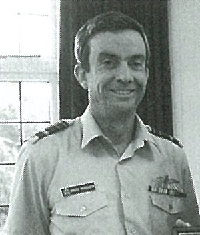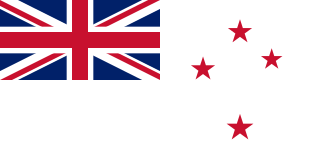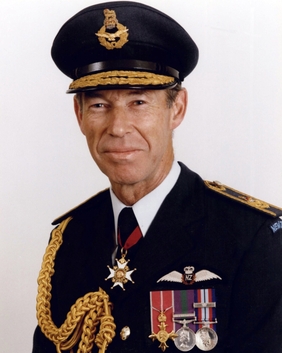Related Research Articles

The Royal New Zealand Navy is the maritime arm of the New Zealand Defence Force. The fleet currently consists of nine ships. The Navy had its origins in the Naval Defence Act 1913, and the subsequent purchase of the cruiser HMS Philomel, which by 1921 had been moored in Auckland as a training ship. A slow buildup occurred during the interwar period, and then perhaps the infant Navy's most notable event occurred when HMS Achilles fought alongside two other Royal Navy cruisers at the Battle of the River Plate against the German ship, Graf Spee, in December 1939.

Air Marshal Sir Bruce Reid Ferguson, is a retired Royal New Zealand Air Force officer who served as Chief of the New Zealand Defence Force and Director of the Government Communications Security Bureau. He took up the appointment when the previous director, Warren Tucker, was appointed as Director of the Security Intelligence Service on 1 November 2006. Ferguson's term of appointment was for four years, stepping down from the role in 2011. Following his retirement, in July 2012, he was appointed as a Justice of the Peace for New Zealand.
Ian Leslie Stuart Blenheim Bradley was a regional councillor in Auckland, New Zealand and a former Commander and Temporary Captain in the Royal New Zealand Navy. He was the father of television presenter Sarah Bradley.

HMNZS Canterbury (F421) was one of two broad beam Leander-class frigates operated by the Royal New Zealand Navy (RNZN) from 1971 to 2005. She was built in Scotland and launched in 1970. Commissioned in 1971, Canterbury saw operational service in much of Australasia and other regions like the Persian Gulf. She undertook operations such as supporting UN sanctions against Iraq and peace-keeping in East Timor. With her sister ship HMNZS Waikato she relieved the Royal Navy frigate HMS Amazon in the Indian Ocean during the Falklands War. Early in HMNZS Canterbury's career, in 1973, she relieved the frigate HMNZS Otago, as part of a unique, Anzac, naval operation or exercise at Moruroa during anti-nuclear protests, supported by a large RAN tanker, providing fuel and a large platform for Australian media. This was due to F 421 being a more modern RNZN frigate, with then current Rn surveillance radar and ESM and a more effectively insulated frigate from nuclear fallout, with the Improved Broad Beam Leander steam plant, for example, being remote controlled and capable of unmanned operation and therefore the ship provided a more effective sealed citadel for operations in areas of nuclear explosions.

The New Zealand Division of the Royal Navy also known as the New Zealand Station was formed in 1921 and remained in existence until 1941. It was the precursor to the Royal New Zealand Navy. Originally, the Royal Navy was solely responsible for the naval security of New Zealand. The passing of the Naval Defence Act 1913 created the New Zealand Naval Forces as a separate division within the Royal Navy.

Vice Admiral Sir Peter Phipps, was a senior officer of the Royal New Zealand Navy (RNZN) from the 1940s to 1960s.
Vice Admiral Rodney Graham Taylor, was a senior officer in the Royal Australian Navy, serving as Chief of Navy from 1994 to 1997. Born in Queensland, Taylor entered the Royal Australian Naval College at the age of thirteen. Graduating as dux of his year in 1957, he later specialised in navigation and served during the Vietnam War. Commanding HMAS Vampire as well as HMAS Torrens, Taylor planned and coordinated the deployment of Australian ships during the Gulf War. Retiring from the navy in 1997, Taylor died from lung cancer in 2002 at the age of 62.
Thomas Henry Logan was a New Zealand water polo player, swimmer, surf lifesaver, dentist and naval officer.
Vice Admiral Sir Neil Dudley Anderson, was a senior officer in the Royal New Zealand Navy (RNZN). He served as Chief of Naval Staff, the professional head of the RNZN, from 1978 to 1980 and as Chief of Defence Staff from 1980 to 1983. He married the author Barbara Anderson in 1951, and the couple had two children. He died on 5 June 2010 aged 83.
Air Marshal Sir Richard Bruce Bolt, was a bomber pilot in the Second World War and a senior Royal New Zealand Air Force officer in the post-war years. He was Chief of the Air Staff from 1974 to 1976 and Chief of the Defence Staff from 1976 to 1980, when he retired from the military.
Commodore George Raymond Davis-Goff was a senior officer in the Royal New Zealand Navy (RNZN).
Air Marshal Sir David Ewan Jamieson, was a senior commander in the Royal New Zealand Air Force. He was Chief of the Air Staff from 1979 to 1983, and Chief of the Defence Staff from 1983 to 1986.
Rear Admiral Edward Courtney "Ted" Thorne, was a senior Royal New Zealand Navy officer. He rose to be Chief of Naval Staff and later served as the Commissioner of the New Zealand Fire Service.

Chief of Navy (CN) commands the Royal New Zealand Navy (RNZN) and is responsible to the Chief of Defence Force (CDF) for raising, training and sustaining those forces necessary to meet agreed government outputs. The CN acts as principal advisor to the CDF on Navy matters, and is the most senior appointment in the RNZN. The rank associated with the position is rear admiral, and CNs are generally appointed on a three-year term.

Air Marshal David Manson Crooks, was a senior commander of the Royal New Zealand Air Force. He was Chief of the Air Staff from April 1983 to October 1986 and Chief of the Defence Staff thereafter until 1987 when he retired.
Sir Geoffrey Ivor de Deney was a British civil servant.
Air Commodore Sir Timothy Charles Elworthy, is a retired Royal Air Force (RAF) officer and courtier.
Robert Josiah Walton was a New Zealand police officer who served as Commissioner of Police between 1978 and 1983. His tenure was marked by the end of the Bastion Point occupation, the Mount Erebus disaster, the 1981 Springbok tour, and the Royal Commission of Inquiry into the convictions of Arthur Alan Thomas for the murders of Harvey and Jeannette Crewe.
The Maritime Component Commander (MCC) is the officer of Commodore rank who directs all the operational forces of the Royal New Zealand Navy. The current postholder is Captain D.G. McEwan, appointed 1 March 2018. MCC directs all the ships of the Navy and several subordinate captains and commanders, most resident several hundred kilometres to the north at Devonport Naval Base in Auckland.
Rear Admiral Ian Alexander Hunter was an officer of the Royal New Zealand Navy, who served as Chief of Naval Staff from March 1991 to April 1994.
References
- 1 2 3 "No. 53697". The London Gazette (2nd supplement). 11 June 1994. p. 36.
- 1 2 Taylor, Alister, ed. (2001). New Zealand Who's Who Aotearoa 2001. Auckland: Alister Taylor Publishers. p. 862. ISSN 1172-9813.
- ↑ Lambert, Max (1991). Who's Who in New Zealand, 1991 (12th ed.). Auckland: Octopus. p. 624. ISBN 9780790001302.
- ↑ "Appointments, Promotions, Extensions, Transfers, Resignations and Retirements of Officers of the Royal New Zealand Navy". New Zealand Gazette . 18 May 1995. Retrieved 17 July 2019.
- ↑ "RNZN and the Rum Issue". Torpedo Bay Navy Museum. 3 October 2015. Retrieved 6 August 2020.